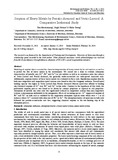Please use this identifier to cite or link to this item:
http://hdl.handle.net/10311/1297| Title: | Sorption of heavy metals by Ferralic-Arenosol and Vertic-Luvisol: a comparative isothermal study |
| Authors: | Mosekiemang, Tlou Dikinya, Oagile Toteng, Elisha |
| Keywords: | Adsorption isotherms Adsorption kinetics Binary-metal system Mono-metal system |
| Issue Date: | 26-Feb-2014 |
| Publisher: | Canadian Center of Science and Education, http://www.ccsenet.org |
| Citation: | Mosekiemang, Tlou. et al. (2014) Sorption of heavy metals by Ferralic-Arenosol and Vertic-Luvisol: a comparative isothermal study, Environment and Pollution, Vol. 3, No. 2, pp. 23-35. |
| Abstract: | Modeling of sorption data is essential for characterizing retention of heavy metals by the soil matrices as well as to predict the fate of heavy metals in the environment. We carried out a study to evaluate adsorption characteristics of metallic ions (Cr3+, Pb2+ and Cu2+) as sole sorbates as well as in coexistence onto clay extracts of Vertic-Luvisol and Ferralic-Arenosol, the generally under-researched yet wide-spread semi-arid soils. Additionally, sorption kinetics of these heavy metals was evaluated in these soils. Equilibrium sorption data for both non-competitive and competitive metal systems were found to obey the Langmuir isotherm. Overall metal loading capacity was higher in Vertic-Luvisol than Ferralic-Arenosol whereas metal-wise affinity to binding sites favoured sorption of Cr3+ over Pb2+ and Cu2+ in that order. Contrary to the hypothesis of this study, the preferential sorption process was found to be driven by cationic properties as opposed to soil properties. Adsorption of metallic ions onto soils was significantly reduced in competitive systems than non-competitive systems, a phenomenon attributable to the antagonistic effects of coexisting species. Cr3+ suppressed sorption of Pb2+ and Cu2+ on both soils as validated by the competitive adsorption capacity ratios which were < 1 in all instances where Cr3+ coexisted with either one of Pb2+ or Cu2+. The adsorption kinetics of metal ions in both soils followed the pseudo-second-order rate law, suggesting chemical sorption as the rate-limiting step of the adsorption process. |
| Description: | First published by Canadian Center of Science and Education on February 26, 2014 in the journal Environment and Pollution, doi:10.5539/ep.v3n2p23 |
| URI: | http://hdl.handle.net/10311/1297 |
| ISSN: | 1927-0909 (Print) 1927-0917 (Online) |
| Appears in Collections: | Research articles (Dept of Chemistry) |
Files in This Item:
| File | Description | Size | Format | |
|---|---|---|---|---|
| Mosekiemang_EP_2014.pdf | 2.25 MB | Adobe PDF |  View/Open |
Items in DSpace are protected by copyright, with all rights reserved, unless otherwise indicated.
